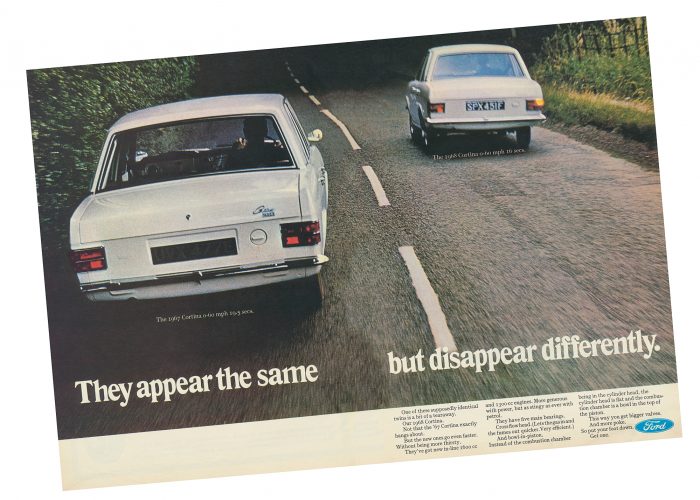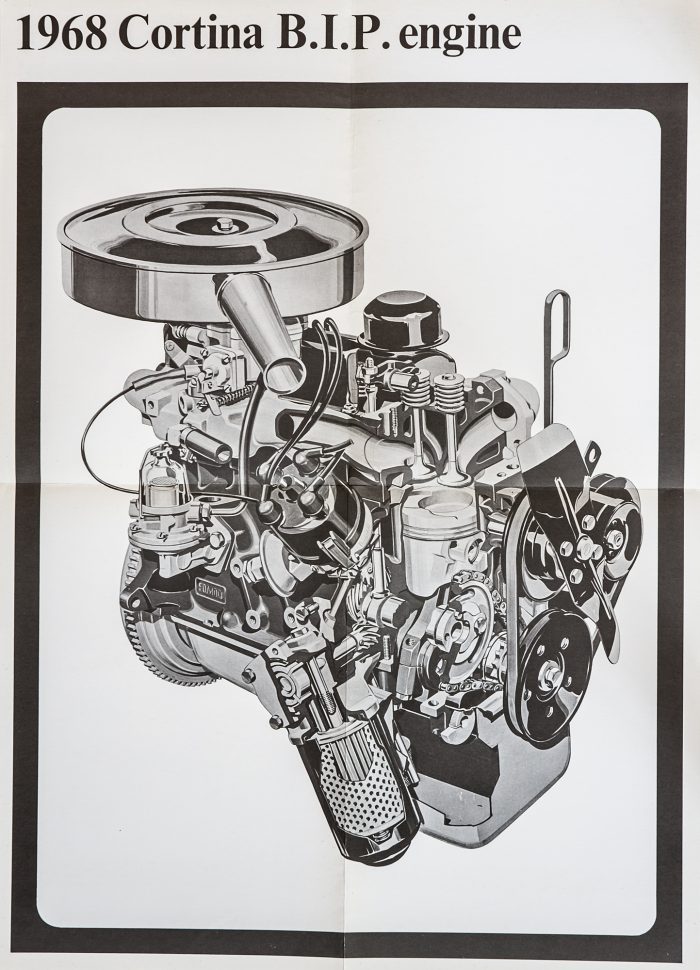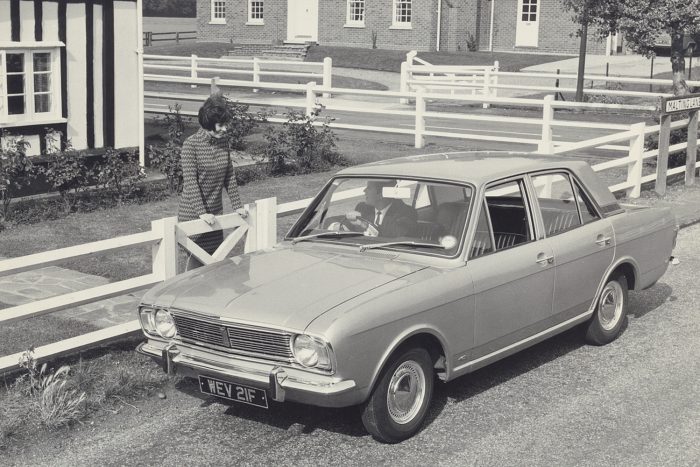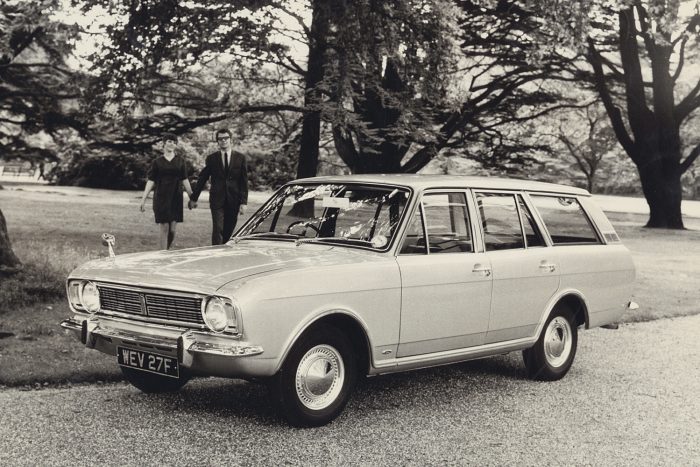“They appear the same, but disappear differently”

Ford announced a number of changes and technical upgrades for the ’68 Cortina on 20th September 1967, stating “these are considerable improvements, more than enough in themselves to justify the Cortina as a new model.” The biggest and most important of these upgrades were new engines for the Deluxe, Super and GT MkII Cortinas

The new engines featured two major design changes. One was the Heron type “Bowl in Piston” combustion chamber, the other was crossflow porting, design principles Ford had first used in the V4 and V6 Essex engines earlier in 1966.
With better breathing in mind, the flat pistons and “bathtub” type heads were gone in favour of moving the combustion chamber into the piston crowns. This, Ford said gave “very close control of combustion chamber shape, volume and surface finish”. The new pistons were heavier but benefits of this new set up far outweighed the downside, for a start it allowed the piston rings to be more favourably placed relative to the source of heat. This provided better heat transfer from piston crown to water jacket. A lower ratio of surface area to volume of combustion chambers gave less heat loss with better thermal efficiency, and the thicker crown transferred less heat to the oil and more into the cylinder walls which helped to extend oil life – service intervals went up to 6000 miles (from every 5000) as a result.
The flat head meant the valves were no longer masked by the combustion chamber sides, and thanks to the new crossflow porting breathing was considerably improved. The rearranged head also put the spark plug in a position providing improved combustion efficiency which in turn helped to lower carbon build up and consequent power loss.
Elsewhere, new valve collets allowed the valves to rotate (at up to 15rpm at maximum engine speed) to prevent localised heat build up and reduce wear and noise and a new patented heat treatment for the valve stems was introduced to give longer valve life. A positive Crankcase Ventilation (PCV) valve was added so the engine would burn its own fumes rather than drop them on the road below, and a new heated aluminium inlet manifold was designed for better cold starting and smoother warm up as well as to give better fuel flow and vaporisation under all conditions.
The new engine was based on the old block which meant all the bolt and push rod spacings were as before and the rocker gear and camshafts remained the same. The longer stroke of the 1600cc engine required a bigger crankshaft and taller block – 0.44 inches taller than the 1500cc it replaced, 1.1 inches taller than the 1300cc. There was a higher grade material specified for the main bearing caps and the big end bolts (which were also thicker), and the rubber asbestos head gasket was replaced with a steel cored part. To reduce noise, and also ring gear wear, the starter motors now had 3 fixings and a pre-engage starter motor became available as an option.
In press releases, Ford said “The new 1,298cc unit (Deluxe saloons and estate cars) develops 5.5 BHP more than the 1967 engine of identical capacity, giving a total power output of 63 BHP (gross). On Super models (saloons and estate cars) there is a new 1,599 cc engine which gives over 20% more power than the previous 1,499 cc unit. GT engine capacity has also been increased to 1,599.”
And talking more about the GT Cortinas Ford told us “the bowl-in-piston/crossflow head design gives 92 BHP compared with the former figure of 83.5. From 0-60 mph takes only 12.5 seconds and maximum speed is raised from 91 to 95 mph. Yet the car still gives touring fuel consumption of around 31.5 mpg.”
The press fleet of MkIIs used to launch the new Crossflow engines wore a series of WEV **F number plates.One of them, WEV 26F, a Super in Saluki Bronze was liked so much by one of the journalists that tested it that he bought it for himself. His widow later donated the car back to Ford where it remains today as part of the company’s Heritage Collection. We were very honored to have been allowed to borrow it to display as part our 50th anniversary celebrations in 2016.
Tremendously successful for Ford, they would still be using the crossflow engine as late as 1982 in the Fiesta XR2 with it making a comeback, albeit in a much modified form, in the first generation Ka. Originally only 1300cc and 1600cc versions were available, but an 1100cc was soon added not just for the MkI Escort but also for the MkII Cortina in certain export markets.
Changes and upgrades made to the individual models included the Deluxes getting them the same door trim style cards vinyl covered dashboards and looped pile carpets (replacing the rubber floor covering) as the other models. The Super was kept ahead of the Deluxe by adding the same remote gear change (though not the gear ratios) of the GT and Lotus Twin Cam models. 4.5J wheels fitted with radial tyres became standard fitment for the GT (and optional for the Deluxe and Supers) and the centre console for the GT and Lotus Twin Cams gained a clock. The Lotus Twin Cam meanwhile got a leather gear stick gaiter and a polished aluminium spoked leather rimed steering wheel.
The whole range benefitted with improvements to the aeroflow system with a redesigned heater. This included a new matrix to change the position of its supply pipes through the bulkhead, a different casing and moved the air flow controls from either side of the dashboard ash tray to the centre of the directional eyeball vents. There was a new more shapely gear lever knob replacing the snooker ball type of the earlier models and the seatbelt buckles were updated too.
In the name of occupant safety, the full width parcel shelf under the dashboard was replaced with a half width collapsible shelf on the passenger side, catches were added to the front seats in 2 door models to stop them tipping forward in the event of an accident, and the interior rear view mirror was enlarged and mounted on a breakaway arm.





